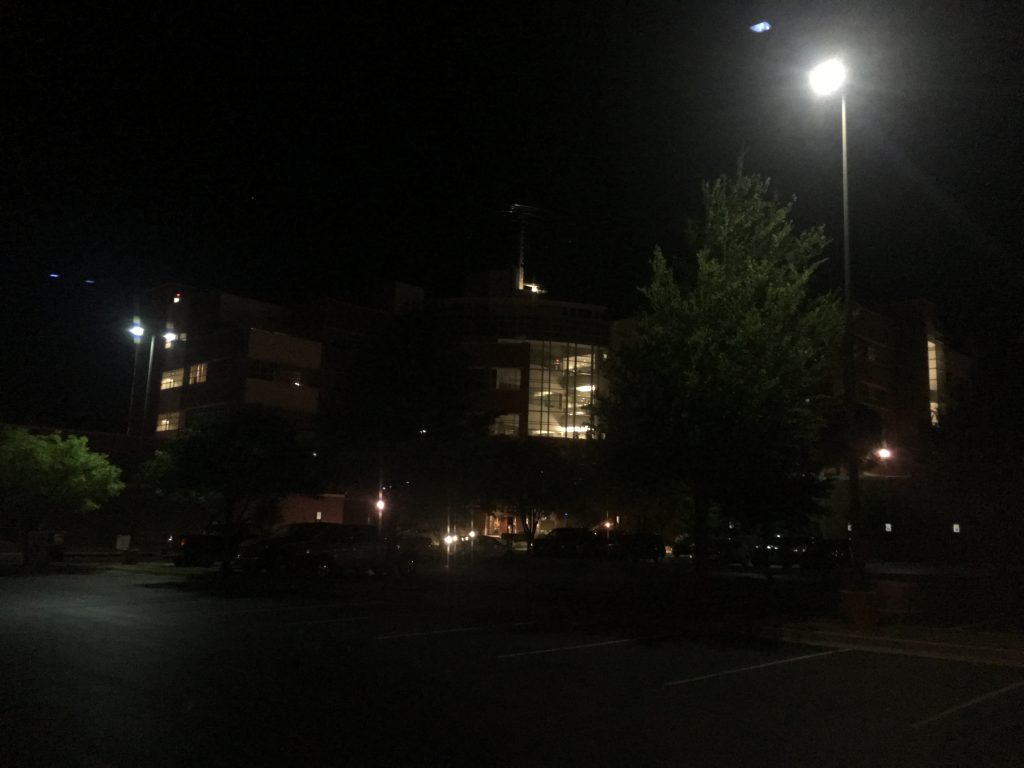I’ll never forget the moment that I learned that I had been selected to be part of a dang tornado research campaign. Elizabeth and I were on vacation, in a cab in Montego Bay, Jamaica. We hadn’t had any contact with the outside world for a couple of days, and so when she turned her phone on we were both stunned to see a message of congratulations from one of her friends. After a moment of frantic searching through her e-mail, we pulled up the list of undergraduate participants in the TORUS 2019 field campaign and saw that, out of 40 students, ours were two of the dozen selected. I didn’t know that it was possible to be even happier than the way you are in the middle of a cruise, but we managed.
Fast forward five months and one ponderous background check, a NOAA ID that I received and promptly lost, hours of defensive driver training online, and meetings about appropriate behavior, and the moment had arrived. I remember waking up on the morning of May 13, fresh off a week of final exams, to a beautiful Monday morning at the National Weather Center. Elizabeth and I had packed suitcases for the adventure of our lives – the chance to hunt storms on the Great Plains for the rest of the month, with the best researchers that Oklahoma, Texas Tech, Nebraska, Colorado, Michigan, and NSSL could field. It seems absurd now, but in the days leading up to the project kick-off, I was worried about my ability to drive the lidar truck, a giant Dodge Ram 2500. Furthermore, I was nervous about spending two and a half weeks sharing a vehicle with seasoned field researchers. I knew Elizabeth Smith, a former TA of mine in a class, but Mike Coniglio was a complete unknown. How would I mesh with the two of them?
The entire OU crew met up in the vehicle bay of the NWC on the morning of the 13th to drive up to Salina, KS, where TORUS media days were to be held on the 14th. Sean Waugh – a tall, energetic guy with a real knack for field meteorological instrumentation – gave a quick pep talk to the group, and it was time to pack up and leave. I wandered over to the lidar truck, for once at a loss for words. The truck, in a word, was epic. Mounted on the bed was a large wooden housing for the lidar, with covered flaps nearer to the cab protecting a large bag for luggage. Nearest to the rear tailgate, four orange tanks held helium (I resolutely tried not to think about what would happen if I wrecked the damn truck and one of the helium tanks popped loose). Within the cab, Mike had a mount in the passenger side for his laptop, and an entire side of the backseat was covered with technology – lidar computer, sounding system, you name it. I think I was, by my standards, pretty subdued in greeting Mike and Liz. That probably suited them just fine.
I was driving the middle beast (anxiously). The nerves calmed down slightly as I eased on to Highway 9 and thence to Home Depot to get some bungie cords to tie down the chair in the truck bed. My comfort level continued to rise as we headed north on I-35 toward the Kansas border.
We were en route to TORUS media days, held at the Salina Airport. That’s one of the only airports centralized in the TORUS target area that has a long enough runway for the P3 – the NOAA Hurricane Hunters.
My first adventure (embarrassment?) of the project came along the Kansas Turnpike south of Wichita. We stopped for lunch at the oasis there, my first of many fast food lunches over the next two weeks. It’s kind of funny, I remember being nervous over where to sit in the dining area with all of the researchers around me – very much first day of middle school vibes. Regardless, the real misadventure came when I tried to gas up the truck, and entered the fleet credit card into the pump. It asked for a driver pin and I entered the number on the keychain’s credit card holder. The gas pump denied my pin. I was flustered. I then went into the gas station and tried to get help from an attendant. I honestly don’t remember if the attendant was any help, but when I headed back out to the truck Liz asked me if the pin was written on the credit card. Which yes, it was. Why would the number of the keychain be wrong but the number on the card be right?** Nothing like not knowing how to fill up your truck to make you feel like a field campaign rookie.
We incurred no other incidents on our way up to Salina, outside of a kind of scary attempt at parking in the Hampton Inn parking lot. I was amused that the hotel was the exact same spot where I’d spent a night after the May 18, 2018 storm chase. Glen Kendrick and I were roommates for the next two weeks, and there were cookies in the lobby. Life was good.
I valiantly tried to get in the science-y mode while waiting for the pre-Media Day dinner by talking with Liz, who was still trying to perfect a program to display lidar data, but when all of the other undergrads from multiple schools wandered by on their way to a Wal-Mart trip, I left Liz to her fate. (If she ever ends up finding this post, sorry.) I went to Wal-Mart looking for a steering wheel cover for our truck, but I’m pretty sure I left with only a bag of Werther’s. Just Nolan things.
That evening, all TORUS researchers from across the spectrum met up at the Salina Olive Garden. This was a wild experience – first of all, I was on a hefty per diem, so why the heck would I not get a margarita? Veteran chasers like Sean talked about war stories from years past, gossiped about which chasers were up to what, and generally made a ruckus of the Olive Garden. It was a fascinating scene to take in.
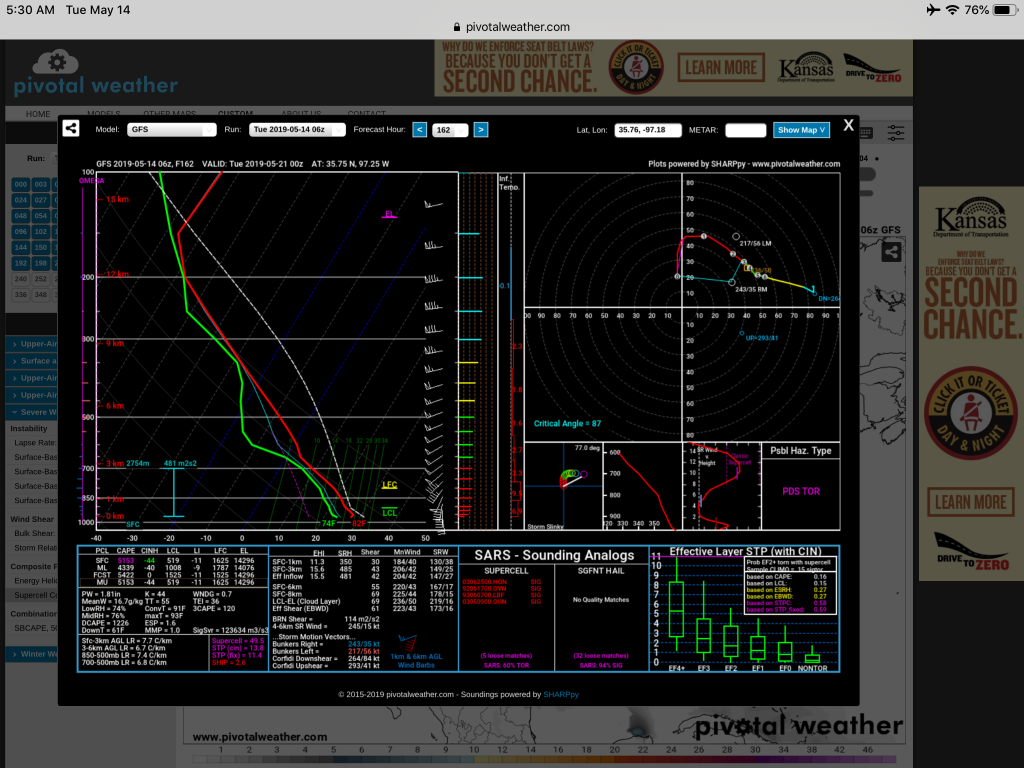
Here is my first screenshot taken on Tuesday, May 14. At 5:30 a.m. I guess I was excited for the coming stretch of weather. To be fair, the morning was an early one, since Media Day was more like Media morning. We had to be to the hangar at Salina Airport by 8:00 a.m. Of course, parking the damn truck inside the hangar turned out to be an ordeal in and of itself, with PR people telling me to angle the truck slightly differently multiple times.
Some of the coolest moments of that day occurred before the press or the public even arrived at Media Day. I got to see some of the other university’s vehicles – the University of Nebraska Comets, mobile Mesonet vans; the University of Colorado MURC, a large van that operated with their UAS teams and has a 50-foot tower; and, coolest of all, the NOAA P-3 Hurricane Hunters. I got to check out the inside of the Hurricane Hunter airplane! Not only that, all of us got the chance to talk to the pilots, who were nice and had a lot of epic war stories. I have pictures, because of course I have pictures:
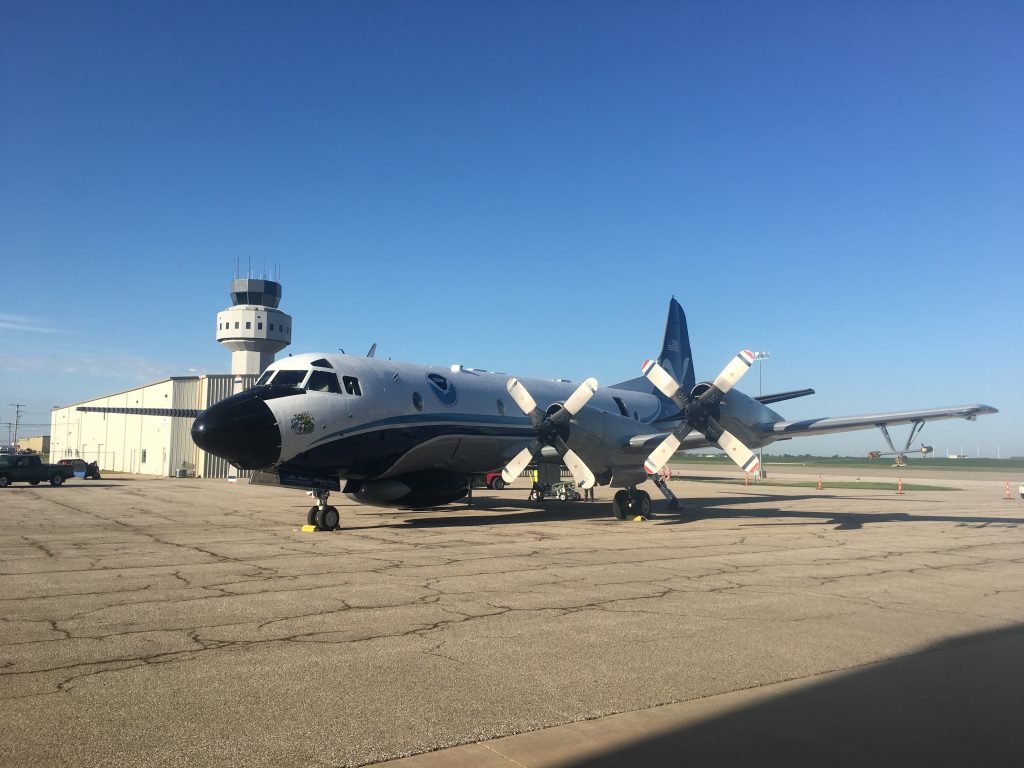
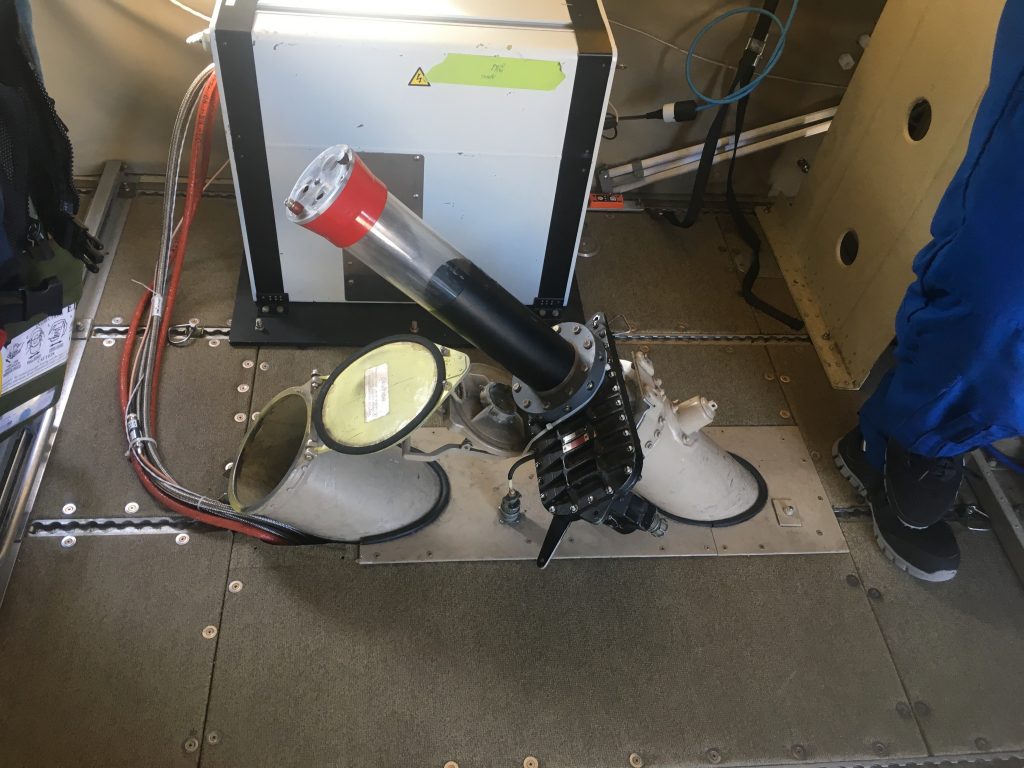
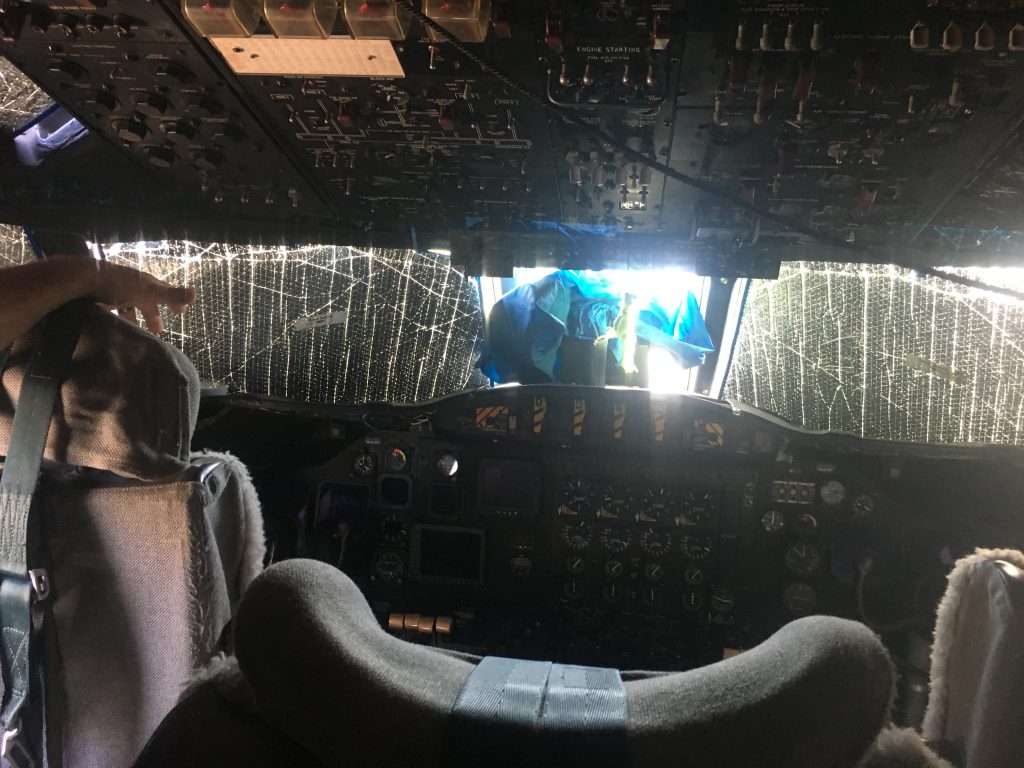
So fricking cool.
Later that morning, after brief speeches from such illustrious speakers as Adam Houston, PI of TORUS, and the Salina mayor, members of the press and public were free to wander the hangar and talk with members of the project. I really enjoyed this. First of all, because it was a weekday in mid-May at a Salina hangar, the only members of the public who showed up were old people and storm chasers. Chasers weren’t going to waste their time on me when legends such as Erik Rasmussen were in the building, so I got to spend my time explaining lidar operations to old people! I probably knew next to nothing about lidar operations at the time, but you’ll never find me lacking for enthusiasm, and Liz told me to just tell everyone we were shooting lasers at the storm. Got it. Here I am, explaining operations (and possibly that we don’t create storms) to people:
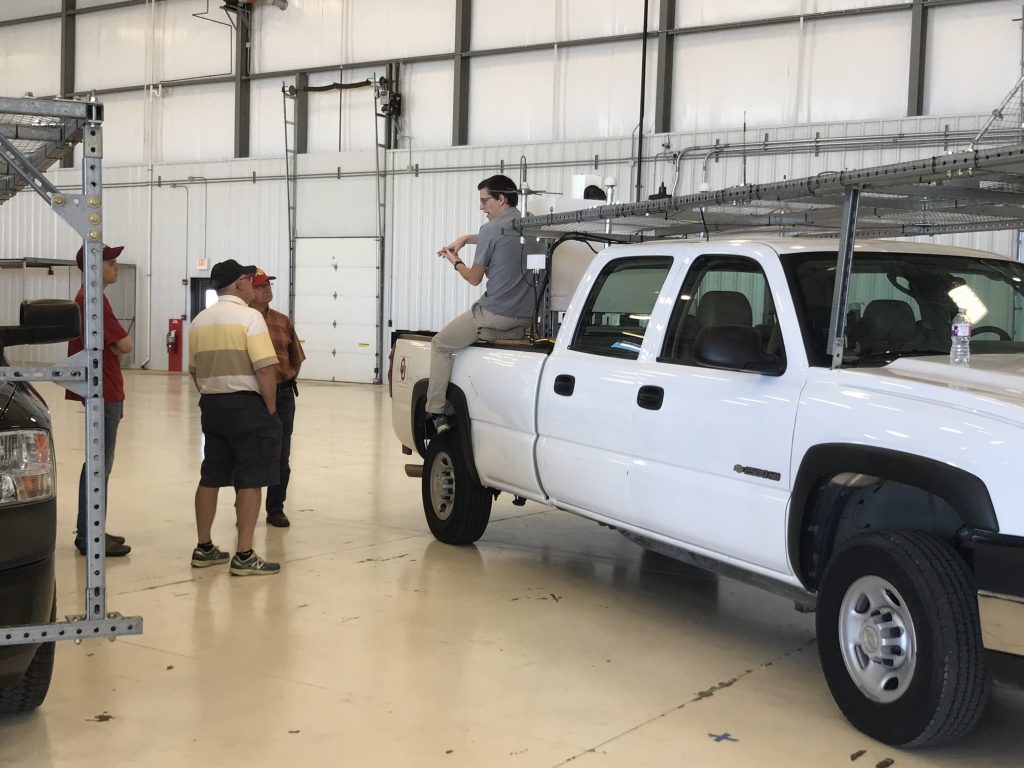
And here’s everybody from OU all lined up for one picture. So many people that I didn’t know at all, a lot of whom I was intimidated by, and all of whom I was about to embark on an epic two weeks with.
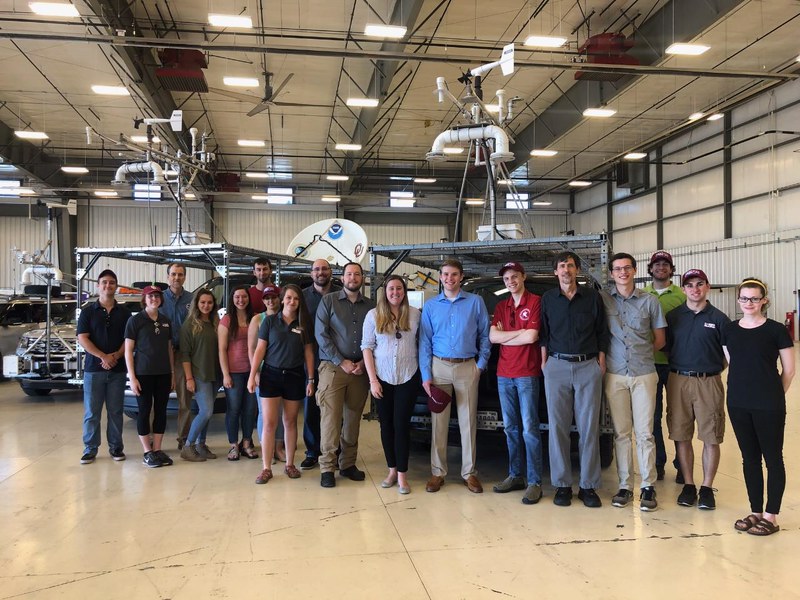
I don’t honestly remember a ton from the rest of the day. I remember eating lunch at Panera in Salina, then (unless I’m mistaken) actually returning to the hangar for more Media Day stuff, before the event was over. I kept a journal for the first week before things got too crazy, and can fill in anything important that I missed. What I do know is that toward evening, with no severe storms on the horizon for May 15 or 16, we decided to break out and prep for down days to start off the operational period. For some schools (University of Michigan, Texas Tech), it made more sense to wait somewhere in the central Plains for a few days. For OU, just a few hours away from Salina, we basically returned to home base the day after driving up. I’ll always remember being struck by a conversation Liz and Manda had while we were on the way back. Despite it being a near-perfectly sunny day, they had identified a tiny boundary near Wichita visually by a few cumulus in the sky and a look at local surface observations. They theorized about how this may have been due to the heavy rain that the region had experienced, and a possible urban-rural differential heating boundary. I felt *so* out of my element. I don’t know why it stuck with me, but it did, and I learned about imposter syndrome because of it!
One thing I did that day that I’ll always be thankful for: I told Liz and Mike that I was really trying to get a capstone project and an AMS poster out of TORUS. The two of them said that that could be done, and sure enough, both things happened.
Of course, I didn’t know that at the time. I didn’t even know what kind of data we were about to collect. Heck, I didn’t even know the amount of storms we were about to see. We got back to Norman late on the evening of May 14, and after I dropped both of my truckmates off at their houses in north Norman (we got in a lot of trouble for doing this, and thereafter everyone had to return to the NWC), I drove back to the Weather Center. Along the way, a song played. It’s a song I always seem to hear on the radio right before something big happens in my life – Even if It Breaks Your Heart, by the Eli Young Band.
As the song says, “Some dreams stay with you forever, drag you around and bring you back to where you were. Some dreams keep on getting better. Gotta keep believing if you want to know for sure”. I was about to live out my dream of being a field researcher on the Plains.
